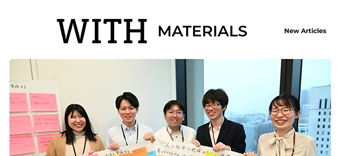- Home
- Sustainability Report
- Mitsubishi Materials Group's Initiatives on Material Issues
- Promotion of DE&I (Diversity, Equity & Inclusion)
Enhancement of Human Capital
Promotion of DE&I (Diversity, Equity & Inclusion)
Diversity, Equity and Inclusion Initiatives
Basic Policy
We have stipulated our basic policies regarding Diversity, Equity and Inclusion in the Basic Policy on Corporate Governance, Sustainability Policy, and Human Rights Policy. We have also established the Guidelines for Support of Women’s Development and Advancement as our policy on promotion of women's development and advancement.
We have posted these basic policies in our internal HR portal website and continue to inform and cultivate the policies for all employees through activities such as explanations during internal training programs.
Starting the fiscal year ending March 2025, we have incorporated equity (fairness and equity) concepts into our basic policies to create a workplace in which individuals from a diverse range of backgrounds can succeed, in an effort to accelerate our existing diversity & inclusion efforts.
◆ Basic Policy on Corporate Governance (Excerpt)
Based on the belief that employees are the source of new values and the Group’s sustainable growth, we aim to maximize organizational performance by creating workplace environments in which team members with diversity in every respect, including race, religion, gender, sexual orientation and gender identity, age, disability, nationality, national origin, social origin, and professional background, can coexist, and recognize one another in an equitable manner, and actively demonstrate their individual abilities at their very best. (Article 10)
◆ Sustainability Policy (Excerpt)
We embrace diversity and acknowledge its importance in creating new value. We will promote Diversity, Equity and Inclusion as a source of sustainable growth within the Group. (Article 3)
◆ Human Rights Policy (Excerpt)
We aim to build workplaces where team members with diverse attributes, values, and experiences can coexist, and respect one another in an equitable manner, and where individuals can work confidently with a sense of growth and fulfillment as they elevate each other and demonstrate their capabilities to the full. (Article 8)
◆ Guidelines for Supporting Women's Development and Advancement
- Actively promoting Diversity, Equity and Inclusion to embrace and respect diverse personalities, as well as to create new values, that are the sources of sustainable growth for the Group. Such promotion is one of our management strategies, and active participation of female talents is indispensable.
- Aiming to be a place where all female talents with diverse personalities can demonstrate their individual abilities at their very best at all workplaces, occupation fields and positions, while experiencing growth and self-realization.
- Fostering culture where every female talent can independently and autonomously build and develop their careers by improving the work environment, expanding the work area and support that respect viewpoints of work.
Medium- and Long-term Objectives and Current Status
We believe that the development of innovation that is not constrained to existing frameworks is needed for the sustainable growth of the Group. Fostering awareness and a corporate culture of retaining and developing a diverse range of human resources, exhibiting mutual acceptance of diverse individual qualities and creating new value from differing views is essential to achieving this. Given this understanding, we have set the following targets based on our policy on diversity, equity and inclusion.
- Ensuring diversity at decision-making levels
Raise the percentage of diverse attributes in management positions (women, non-Japanese, mid-career hires, people with disabilities) from the 16% achieved in the fiscal year ended March 2021 to 30% by the fiscal year ending March 2031.
- Compared with the fiscal year ended March 2021, raise the number of female managers by approximately 2.5 times, the number of non-Japanese managers by approximately 2.5 times, and the number of mid-career hire managers to approximately 1.5 times.
- Raise the number of female managers as a percentage of all managers to 5.0% by the fiscal year ending March 2026.
Targets for the Number of Female, Non-Japanese and Mid-Career Hire Managers
| Subject | FYE March 2026 Target | |
|---|---|---|
| Female managers | Number compared to FYE March 2021: | Approx. 2.5 times |
| Non-Japanese managers | Approx. 2.5 times | |
| Mid-career hire managers | Approx. 1.5 times |
Trends and Targets for Percentage of Women in Management Positions

Number and Ratio of Female Directors, Executive officers and Managers
| Subject | Number | Ratio |
|---|---|---|
| Female Directors (as of June 26, 2023) |
2 (out of 11) | 18.2% |
| Female Executive Officers (as of April 1, 2024) |
1 (out of 8) | 12.5% |
| Female Managers (as of April 1, 2024) |
58 (out of 1,726) | ★3.4% |
Our Initiatives
To accelerate transformation through integrating diverse values, we are carrying out measures to ensure diversity and disseminate equity and inclusion.
<Ensuring diversity>
| General |
|
|---|---|
| Support of women’s development and advancement |
|
| Support for non-Japanese employees |
|
| Support for mid-career hires |
|
| Support for employees with disabilities |
|
| Career support |
|
<Dissemination of equity and inclusion measures>
| General |
|
|---|---|
| LGBTQ+ Support |
|
| Support for male employees to take childcare leave |
|
Support for Male Employees to Take Childcare Leave
We are further promoting diversity, equity and inclusion by creating an environment in which diverse human resources can work sustainably and achieve a balance between work and life events, including childcare. We have set a target of 100% for male employees to take childcare leave from the fiscal year ended March 2023 onward, and are actively working to achieve this goal by raising awareness through training and awareness-raising activities, holding seminars on reviewing work styles and promoting male employees to take childcare leave, and other measures.
Trends for Percentage of Male Employees to Take Childcare Leave

Promoting Employment of People with Disabilities
We engage in a range of initiatives to promote the employment of people with disabilities.
Many employees with disabilities work at the Marunouchi Head Office and the Saitama Office, a “model workplace for disabled employees” aimed at enabling people with disabilities to learn, grow and contribute to society through their work.
At the Marunouchi Head Office, we mainly provide jobs such as cleaning and sterilization of the cafeteria and meeting rooms. At the Saitama Office, in addition to cleaning and sterilization of the cafeteria and training and accommodation facilities, the jobs include maintaining greenery on company premises, and producing business cards, including for the Group companies. We assign guidance staff to each workplace to respect the individuality and potential of each employee with a disability, innovate and improve how they work, and to foster their growth in a way that promotes a sense of fulfillment and job satisfaction.
We also accept the internship of students from local schools for special needs education, actively hold events such as company tours, and support the employment of students attending schools for special needs education, such as by motivating them to work at a company through these activities.
- Holding a DEI Forum
-
To promote understanding and improve awareness of DE&I and accelerate initiatives throughout the industry, we held a DEI Forum on International Women’s Day (March 8) 2024 through cooperation between eight nonferrous metal companies and the Japan Mining Industry Association.

- Received a "Gold" Award in the PRIDE Index 2024
-
We have received a "Gold" award in the PRIDE Index 2024*, which is an evaluation index of corporate engagement with LGBTQ+ and other sexual minorities.
- * The PRIDE Index is an evaluation index first developed in Japan in 2016 by "work with Pride," a voluntary organization.

- Sponsorship of Tokyo Rainbow Pride 2024
-
We attend this event to support LGBTQ+ people. We are promoting an inclusive corporate culture and working to build working environments where everyone can shine in their own unique way.

Click here to learn more about our Diversity, Equity & Inclusion.
- * This data is only available in Japanese on the website.







